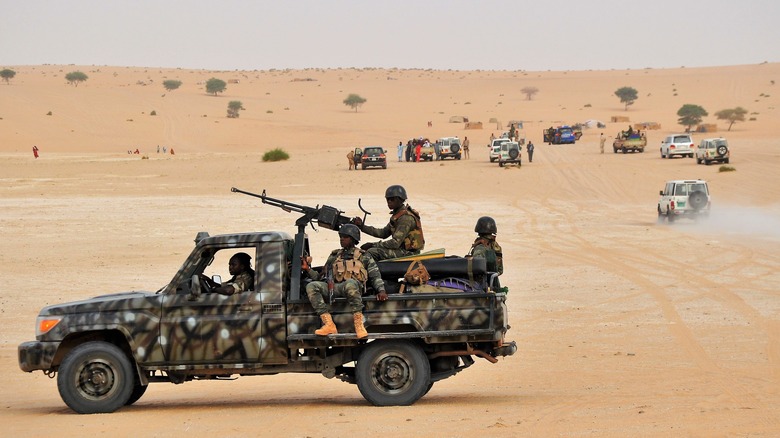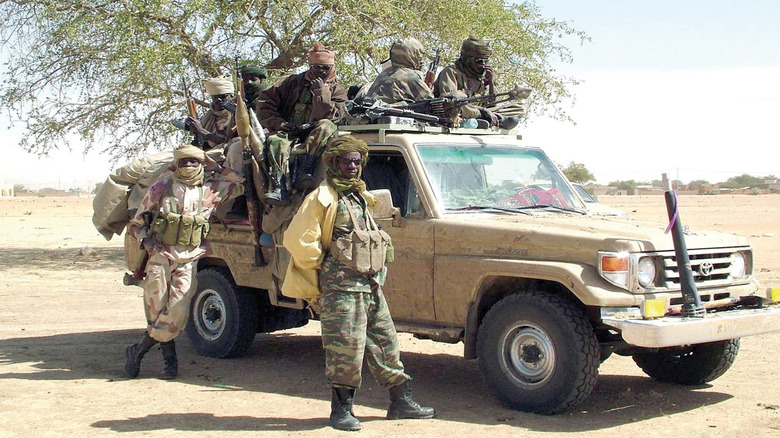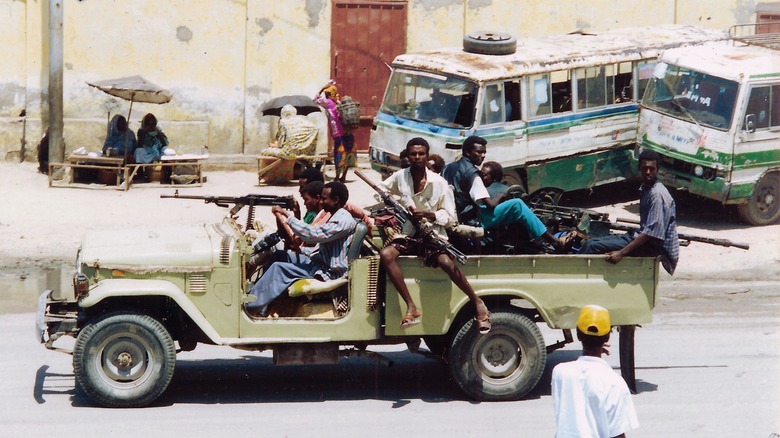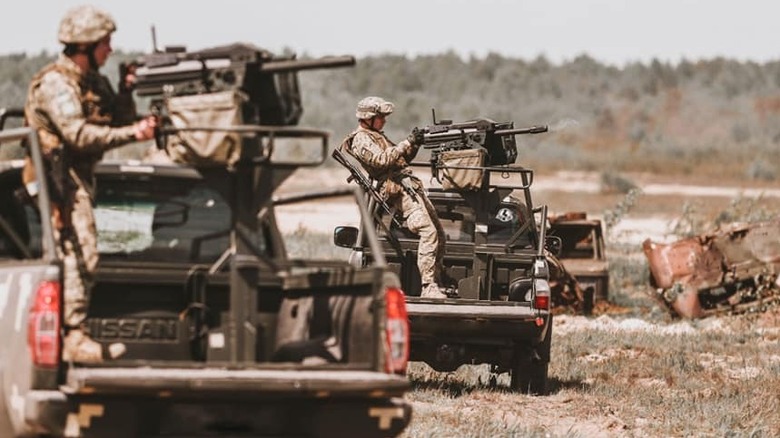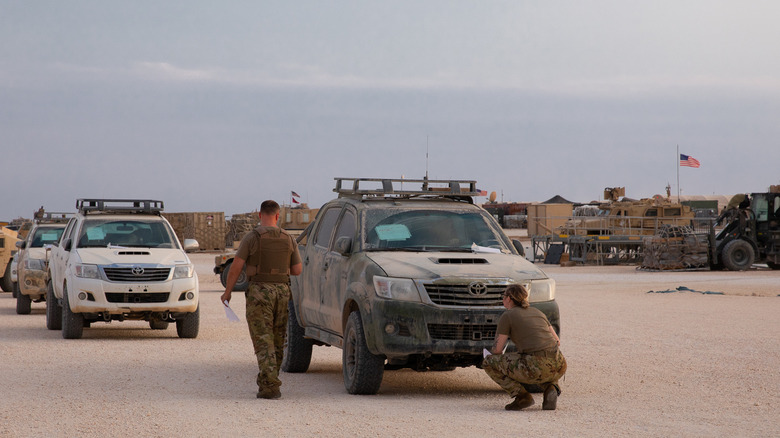The Great Toyota War: How Toyota Cars Changed The Nature Of Modern Warfare
Whenever the "bad guys" roll onto the screen in Hollywood war movies, chances are they're driving Toyota pickup trucks. From "The Hurt Locker" in 2008, to "American Sniper" in 2014, Toyotas — much like AK-47 rifles — have become shorthand for the enemy forces. This is no mere moviemaking quirk, but a reflection of reality: the favorite ride to war for militias and armed groups around the world are Toyota Hiluxes.
Like the legendary AK-47, Toyotas are inexpensive, plentiful, and extremely durable. A used Toyota Hilux pickup of any generation can be had for $10,000 to $20,000 in the Middle East, and there are thousands of Toyota dealers — official or not — in over 170 countries worldwide. The Hilux especially has earned a reputation for being virtually indestructible. It's a reputation that's been proven true on the TV show "Top Gear," where a Hilux was crashed, drowned, battered by a wrecking ball, and even dropped from a demolition site — yet the engine still ran when revved. All these factors make Toyotas the perfect low-budget "military mules" for armed groups.
The proliferation of Toyotas in conflict zones only took off after a single 1987 episode during the Chadian-Libyan war. In what became known as the "Toyota War," Chad's forces used fleets of Hilux and Land Cruiser trucks so decisively that it demonstrated their military value to rebel forces everywhere.
[Featured image by NigerTZai via Wikimedia Commons | Cropped and scaled | CC BY-SA 4.0]
The Chadians and the anti-tank Hiluxes
In 1984, the African nation of Chad was torn in two along the 16th parallel. The north was held by Libyan-backed rebels who rejected Chad's president Hissène Habré, while the south remained under Habré's French and U.S.-supported government. Two years later, a powerful rebel faction called the Transitional Government of National Unity (GUNT) turned against Libya, and joined forces with Habré. Emboldened, and with French air support, Habré mobilized his army to push Libyan forces out of Chad.
The turning point came on January 2, 1987, at the Battle of Fada, the first clash in the so-called "Toyota War." Fada was a rebel stronghold backed by Libyan arms, tanks, and armored vehicles. Instead of a costly head-on assault, the Chadians opted for a rezzou-style battle — a type of blitz, hit-and-run style of warfare practiced by the Bedouins. Where the Bedouins once used horses for lightning mobility and javelin charges, the Chadians substituted them with Toyota pickup trucks mounted with MILAN anti-tank missiles.
The motorized forces surrounded and overwhelmed the defenses of Fada in a day. Hundreds of Libyan soldiers were killed, while the missile-armed trucks proved devastatingly effective against their clustered armored forces, with up to 100 Libyan tanks and armored vehicles destroyed. Habré's forces lost just 18 men and 3 pickup trucks in this lopsided victory.
[Featured image by the Ministry of Defence and Armed Forces of the Czech Republic via Wikimedia Commons | Cropped and scaled | Attribution Only License]
The rise of the technicals
These improvised gunned-up pickup trucks are known as "technicals," and their military use actually dates back to World War II. The British Long Range Desert Group pioneered deploying technicals with great success against Axis forces during the North African campaign. However, it was the so-called "Toyota War" — despite being a relatively small regional conflict — that really popularized technicals for modern rebel and militant groups around the globe.
After Chad's forces used fleets of Toyota pickup trucks so decisively in 1987, technicals began appearing in conflict zones everywhere. They were employed against U.N. peacekeepers by Somali militias, including the group involved in the infamous "Black Hawk Down" incident. Technicals remain common among Somali warlords and pirate gangs to this day.
In the Middle East, the pre-2021 Taliban's mechanized forces were largely comprised of technicals, as were those of terrorist groups like Al-Qaeda and ISIS. Photos from conflicts in Lebanon, Sudan, Syria, and Yemen are filled with gun-mounted pickup trucks serving as battle wagons. So, all thanks to the Toyota War's influence, the technical has become the "rebels' Humvee" today — a cheap, rugged, and readily available warhorse for insurgents and militias with limited means.
[Featured image by CT Snow via Wikimedia Commons | Cropped and scaled | CC BY 2.0]
What makes a technical?
While Toyotas are the most common base, technicals don't necessarily require that specific platform. Any four-wheel-drive pickup truck — whether a Ford, Chevy, or other make — can be turned into a technical simply by mounting a weapon on it. And that's the real magic of these improvised gun-trucks: with just a few hours' work in a garage and some inventiveness, they can be outfitted for almost any battlefield role.
Most often, technicals are fitted with machine guns like the M2 Browning or Soviet DShK to provide mobile firepower. They can also take on a limited anti-aircraft role by adding gun mounts like the ZU-23-2 — a configuration frequently used by Syrian rebels to combat the regime's superior airpower. Recently in Ukraine, rebels have even jury-rigged truck beds with launch tubes salvaged from Grad rocket artillery as an alternative to conventional missile vehicles (dubbed "Nightmaremobiles"). There are also reports of U.S. VAMPIRE laser-guided rocket kits being mounted on technicals for drone defense, as well as U.K. Brimstone laser-guided missiles.
But the true "magic" is that a technical's weapon capabilities are really limited only by the ingenuity of its makers. Syrian rebels have bolted entire turrets from BMP infantry fighting vehicles onto trucks for heavy fire support. Yemeni forces have even mounted R-60 air-to-air missiles on Hilux pickups to create a poor man's SHORAD system.
[Featured image by Ministry of Defense of Ukraine via Wikimedia Commons | Cropped and scaled | CC BY 4.0]
Versatile, but highly vulnerable
While troops call them "technicals", the Pentagon has a fancier name: non-standard tactical vehicles (NSTVs). The U.S. military had experimented with the technical concept as far back as 1983, when the 9th Infantry Division was designated a "High-Technology Test-Bed." This unit was re-organized with "Fast Attack Vehicles" (later called Desert Patrol Vehicles) — essentially dune buggies with mounted grenade launchers or machine guns, fitting the definition of a technical — albeit an expensive one. While performing well in exercises, the concept never caught on because the unarmored FAVs proved extremely vulnerable to artillery fire. They struggled against heavily armed and armored mechanized forces in static defensive battles.
That highlights the key disadvantage of technicals. While cheap and versatile, they can't truly replace or match the combat effectiveness of purpose-built military vehicles like the MRAPs or Humvees. To compensate, armed groups often weld steel plating onto their technicals. This offers limited protection against small arms and shrapnel, but they remain defenseless against any serious firepower.
The armed Toyota pickup shows no signs of disappearing from modern battlefields anytime soon. However, while they can augment regular military forces (U.S. special operations have been known to employ technicals for their flexibility and ease of use), for conventional armies, they're still no substitute for true armored fighting vehicles.
